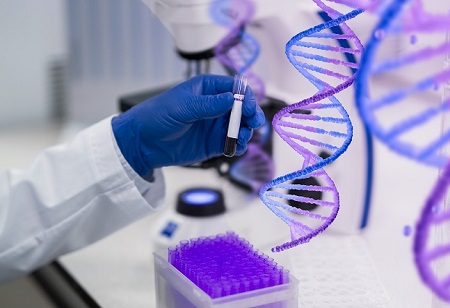Rejith P R, Correspondent, India Pharma Outlook

FDA has recently approved two groundbreaking treatments, Casgevy and Lyfgenia, which characterize the cell-based gene therapies for treating sickle cell diseases in individuals 12 years and older. Casegevy was the first approved treatment to use a type of novel genome editing technology, showcasing the latest advancement in the field of gene therapy.
The global gene editing market was evaluated to be worth USD 5.3 billion in 2023 and is expected to reach USD 10.6 billion by 2028, with a CAGR rate of 15% from 2023 to 2028.
George Church, Geneticist, Professor at Harvard Medical School said "We're not just editing the genome; we're editing the epigenome. We're not just editing genes that are identical; we're editing genes that are similar. We're not just editing one gene, but multiple genes simultaneously. We're not just editing somatic cells but also the germline."
Below are the applications of Gene Editing in Treating Genetic Disorders:
Gene Replacement Therapy
There are certain cases in Gene Replacement Therapy in which the aim of gene editing is not to rectify a mutated gene but to replace it entirely. Mainly, it is significant for genetic disorders where a gene is comprehensively non-functional. Utilizing this therapy engages in unveiling a functional copy of the gene into the impacted cell, effectively changing the problematic gene with a healthy one.
For instance, Duchenne muscular dystrophy (DMD) is a medical condition that causes skeletal and heart muscle weakness that quickly gets worse with time. With the help of gene editing technologies, medical professionals can put a functional dystrophin gene into the cells of affected patients, treating the disease's primary cause.
Jennifer Doudna, Biochemist, Editas Medicine said "We have the ability to repair, replace, and eliminate genes in a very targeted and precise way. This opens up the possibility of curing genetic diseases."
Healing of Disease-Inducing Mutations
The healing of disease-causing mutations is one of the principal applications of gene editing in treating genetic illnesses. A lot of genetic disorders are an outcome of specific mutations in a person's DNA. Gene editing technologies like CRISPR-Cas9 deliver the capability to target and fix these mutations, delivering a therapeutic way to address the root cause of the disorder.
To illustrate the fact, Illnesses like sickle cell anaemia and beta-thalassemia are caused by mutations in the haemoglobin gene. Scientists use gene editing to rectify these mutations, restore the gene's normal function, and lower the disease symptoms.
Paul Berg, Former Biochemist, Stanford University said " I think that, in the long run, genetic engineering is going to lead to a very new and powerful kind of medicine."
Suppression of Disease-Causing Genes
Gene editing can restrict the expression of disease-causing genes without directly changing the DNA sequence. It can be accomplished through technologies, such as RNA interference (RNAi) or CRISPR interference (CRISPRi), which require the targeted silencing of specific genes.
For example, Huntington's disease is a genetic condition that can be inherited if a person has a mutated huntingtin gene. Gene editing technologies have the potential to suppress the expression of the mutated gene, which can effectively lower or even prevent the development of the disease.
Feng Zhang, Founder, Beam Therapeutics said “The thing everybody should focus on is how we can push this technology forward, so we can actually treat a disease,”
Formation of Designer therapies
Gene editing permits the formation of customized design therapies that are specifically tailored to a patient's unique genetic makeup and the technology allows for the development of personalized medication that takes into account an individual's genetic profile for treatment, resulting in significantly improved outcomes. By targeting specific genetic mutations through tailored gene therapies, treatment efficacy can be increased while avoiding any potential adverse effects.
Francis Collins, former director, National Institutes of Health said "Gene editing technologies offer great promise but also raise important ethical questions. Human germline editing for reproductive purposes raises those concerns to a level that demands significant public engagement before any further clinical research."
In a nutshell, gene editing has already provided a significant advancement in medical science, delivering expectations for treating genetic abnormalities at their root cause. Although there may be challenges with this technology, the present research and development plays a crucial role in integrating gene editing methods into mainstream medical practice. Medical professionals dealing with the latest gene technology should employ it in a systematic way to secure better results. As the medical technology of gene editing continues to evolve, it holds the key to unleashing the full potential of dealing with individuals affected by genetic disorders.